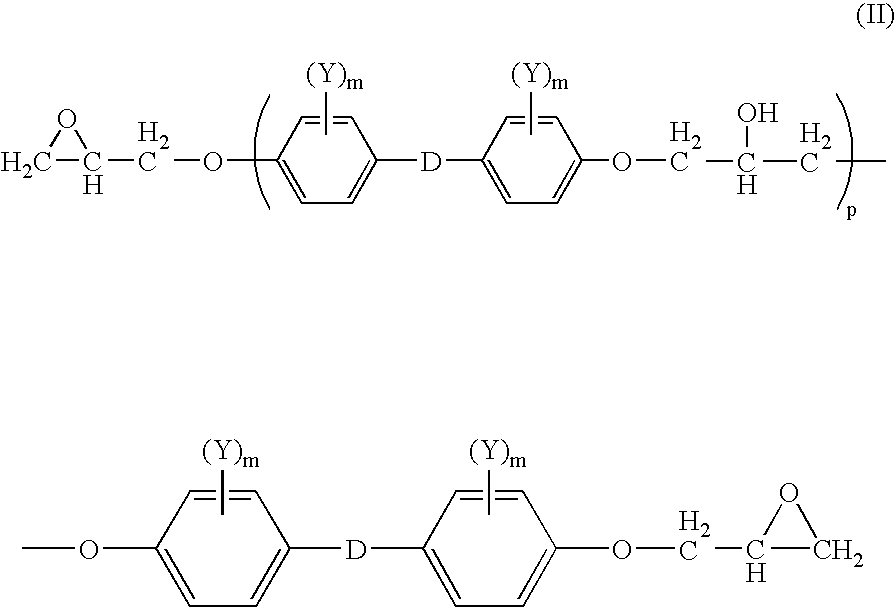Oligomeric halogenated chain extenders for preparing epoxy resins
- Summary
- Abstract
- Description
- Claims
- Application Information
AI Technical Summary
Benefits of technology
Problems solved by technology
Method used
Image
Examples
examples 3-10
[0092]Oligomer Example 3 is prepared in the same general manner described with respect to the preparation of halogenated oligomer Examples 1 and 2, using proportions of starting materials as indicated in Table 2.
[0093]Oligomer Example 4 is prepared in the same manner as Oligomer Examples 1 and 2, except that after the TBBA / D.E.R.542 mixture has reacted, a small quantity of a non-halogenated epoxy resin, D.E.R.330, is added and allowed to react to increase the molecular weight of the oligomer. Proportions of starting materials are as indicated in Table 2.
[0094]Oligomer Example 5 is prepared in the same manner as Oligomer Example 4, using proportions of starting materials as indicated in Table 2.
[0095]Oligomer Example 6 is prepared in the same general manner described with respect to Examples 1 and 2, using proportions of starting materials as indicated in Table 2.
[0096]Oligomer Examples 7 and 8 are prepared in the same general manner described with respect to Examples 1 and 2, except...
example 11
[0108]Oligomer Example 11 is prepared by charging 752.8 parts of D.E.R. 560 epoxy resin, 1350.2 parts of TBBA and 1402 parts of Dowanol PM to a 10 liter steel reactor equipped with a mechanical stirrer, a heating jacket, a nitrogen inlet and a condenser. The reactor contents are heated to 100° C. to form a resin solution. 3.1 parts of ethyltriphenylphosphonium acetate catalyst, based on the combined weight of the epoxy resin and TBBA, is added to the resin solution. The solution is then heated to 110° C. and held at that temperature for 50 minutes until the epoxy content is reduced to about 2.5 percent based on the weight of the reactive starting materials. The solution is then cooled to 60° C. to produce a solution Oligomer Example 11. The ratio of phenolic groups to residual epoxide groups in Oligomer Example 11 is approximately 3.75:1.
[0109]7554.8 parts of an 85% by weight solution of D.E.N. 438 epoxy novalac in Dowanol PM is added to the solution of Oligomer Example 11. The resu...
example 12
[0113]Oligomer Example 11 is prepared by charging 896.5 parts of D.E.R. 560 epoxy resin, 1071.8 parts of TBBA and 1312.2 parts of Dowanol PM to a 10 liter steel reactor equipped with a mechanical stirrer, a heating jacket, a nitrogen inlet and a condenser. The reactor contents are heated to 100° C. to form a resin solution. 2.95 parts of ethyltriphenylphosphonium acetate catalyst, based on the combined weight of the epoxy resin and TBBA, is added to the resin solution. The solution is then heated to 110° C. and held at that temperature for 65 minutes until the epoxy content is reduced to about 3 percent based on the weight of the reactive starting materials. The solution is then cooled to 60° C. to produce a solution Oligomer Example 12. The ratio of phenolic groups to residual epoxide groups in Oligomer Example 12 is approximately 2.5:1.
[0114]6422.5 parts of an 85% by weight solution of D.E.N.438 epoxy novalac in Dowanol PM is added to the solution of Oligomer Example 11. The resul...
PUM
| Property | Measurement | Unit |
|---|---|---|
| Temperature | aaaaa | aaaaa |
| Temperature | aaaaa | aaaaa |
| Temperature | aaaaa | aaaaa |
Abstract
Description
Claims
Application Information
 Login to View More
Login to View More - R&D
- Intellectual Property
- Life Sciences
- Materials
- Tech Scout
- Unparalleled Data Quality
- Higher Quality Content
- 60% Fewer Hallucinations
Browse by: Latest US Patents, China's latest patents, Technical Efficacy Thesaurus, Application Domain, Technology Topic, Popular Technical Reports.
© 2025 PatSnap. All rights reserved.Legal|Privacy policy|Modern Slavery Act Transparency Statement|Sitemap|About US| Contact US: help@patsnap.com



